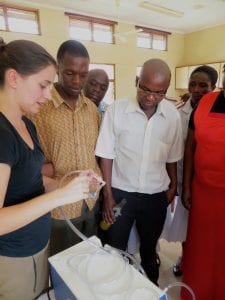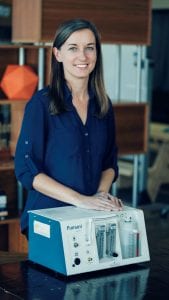BY MALAZ MOHAMAD ’16
It was a very chaotic situation: a young child had come in with bronchiolitis. She was breathing very rapidly and with every wheezing breath, I felt my own throat tighten. The nurses and doctors rushed about but seemed unfazed by the girl’s apparent distress; they saw children like her on the regular. A nurse quickly strapped her to the Pumani. She started to regain her breathing. It took only a matter of minutes for her breath to calm. And just like that – I witnessed my invention being used for the first time. It was honestly too much for me to explain: the worst and the best in the span of minutes.
In 2010, Jocelyn Brown was a bioengineering student who became interested in the Global Health Technologies minor because one of her friends interned in Haiti. The prospect of interning in such an exotic location was what first drew her to Rice 360°; she had no idea that she would make history.
As part of her senior design project, Brown developed a pediatric respiratory device: a simple, affordable “bubble CPAP” to help resuscitate newborns experiencing respiratory distress. Shortly after graduation, Rice 360° hired her as a program associate to continue her work on the Pumani (the device’s name, which translates to “breathe restfully” in Chichewa, the language of Malawi).
For a year, Brown worked out of Houston on designing and refining the design of her device. Later, she moved to Blantyre, Malawi to clinically evaluate the device. There was much anticipation and promise as the Pumani trials led to a reduction in neonatal mortality by 27% in Malawian tertiary hospitals. And this was at 5% the cost of equivalently performing devices in U.S. hospitals.
Brown’s design, under the leadership of Dr. Rebecca Richards-Kortum and Dr. Maria Oden, has raised over $2.2 million dollars and has reached more than 45 different countries. Brown herself has received numerous awards including being named one of Forbes’ 30 under 30 in Science and Healthcare. She also presented her design at the White House as part of an Innovations in Global Development event.
I sat down with her for a few questions:
What powered you through such an ambitious and big picture project?
I think there are two groups of people that have motivated me: 1) mothers and their newborns, who deserve access to quality care regardless of where their child is born; 2) healthcare workers who work tirelessly to care for these mothers and newborns, and frequently don’t have the equipment they need to help their patients.
I’ve been able to meet and work with people in both of these groups, and I think when you know the names and faces of people who are impacted by your work, it’s impossible to forget them.
Did you have a moment when you decided “Yes, I want to do this” or did it just happen for you? Did it require a leap of faith?
There really wasn’t an exact moment. I think the combination of working with an incredibly dedicated group of professors and clinicians, and knowing that the hospital in Malawi specifically asked for and was prepared to use our CPAP was incredibly motivating. Moving to Malawi was probably the biggest leap of faith – but I always knew that I wanted to work abroad, and I didn’t really have to think about the decision, I just went for it.
What do people not realize about your work?
I think people might be surprised at how long the time frame for this work can be. If I told my senior year self that it would take 5 years for the CPAP to reach commercialization, I would have been very intimidated and discouraged. I think breaking the process up into small steps definitely helps, and not necessarily working towards a ‘5 year goal,’ but maybe a 6 month or 1 year goal, over and over again.
What was the most difficult part of the journey?
The decision to leave Malawi was pretty difficult, as I had spent over 2 years working with the local team and felt very committed to our work. I had seen pretty much every expat I knew in Malawi come and go, and a part of me hated to be yet another foreigner who left after some time. But I also was very motivated to expand the Pumani reach beyond Malawi, and I knew that in order to do that, I needed to join 3rd Stone Design and bring Pumani to the worldwide market.
What was the greatest lesson you learned?
You have to focus on individual people and stay motivated by incremental achievements. If I went into this journey thinking, I aim to bring the Pumani to over 20 countries and treat thousands of newborns, it might be easy to lose sight of why I do this work. Meeting individual moms and newborns whose lives have been changed by the Pumani, and hearing positive feedback from a nurse about how she likes using the Pumani – these are the things that keep me going, not the larger picture statistics or long-term goals
What is your hope going forward?
My long-term dream is that this kind of work — bringing low-cost medical devices to market — is not such a difficult and undefined path. I can’t underestimate the ability of our dedicated team to make the CPAP a reality, but I also hope this kind of work can be done by many other groups of engineers and clinicians in the future. This work really shouldn’t be so hard, especially if the outcomes are so impactful.
Our guest blogger, Malaz Mohamad, is a graduate of the Rice 360° global health technologies minor. While at Rice, she also majored in psychology.

